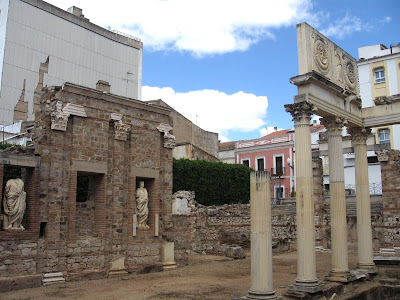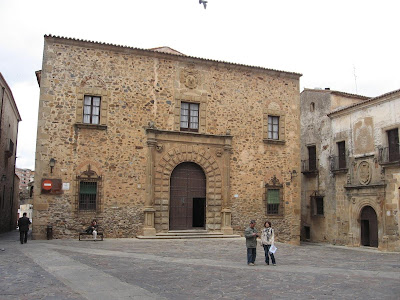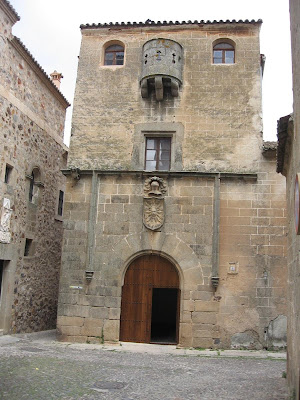Saturday 11th April 2009, Elvas, Portugal
Tonight we are camping in high winds on a very dusty site just 15 kilometres from the Spanish border. Away from the coast we expected Portugal to be warmer but it is really chilly with the wind whistling in around the back door. It's time to turn back to the north. Paradoxically the further south we get the colder it becomes!
We took our last look at the sea for some time as we left Cascais, heading inland towards Mafra. This is a friendly little town that forms the most unlikely setting for a mega monastery constructed in the early 18th century with wealth amassed by Portugal from Brazil. At the height of its construction it employed 45,000 workers on a daily basis. We got the definite impression that it just kept getting bigger as the king tried to dispose of some of the money that kept pouring in.
Really it is obscenely huge, particularly when the money used was taken at the expense of the native population in Brazil. It is Italianate baroque in style, over ornamented with extravagant use of marble.

The little town though is very pleasant. We browsed the streets and the market, where we bought custard tarts from a friendly gentleman who carefully wrapped them into a little parcel for us and charged a mere euro for the two. In the pasteleria we asked for a couple of bowls of vegetable soup. It is one of the nicest things about Portugal. It can be bought almost everywhere and is invariably delicious. Our two bowls cost 1.70 euros together!
It has been a day of driving. It took ages driving across country to get around Lisbon but eventually we crossed the river Tejo by the first bridge upstream that did not sweep us up into Lisbon's conurbation.

On the other side of the lagoon formed by the River Tejo we passed through flat wetlands quire unlike the hilly landscape we had become accustomed to in Portugal. Soon we were driving through a sandy landscape of heathland where eucalyptus trees, olives and most of all cork oak trees flourished. The cork had been removed from the trunks of the trees and we saw piles of it waiting to be transported. It takes eight or nine years for the trees to recover and grow a new bark. Along the roadsides we frequently passed huge, gangly storks standing on large nests of untidy sticks they had proudly constructed on telephone poles and rooftops. The roads were straight and monotonous with an unchanging landscape for many miles. Inland Portugal is sparsely populated and although the countryside was perfectly pleasant, it was unvarying. There are no campsites, indeed no habitation, in such areas so we had to continue until we arrived here around 6pm. It's not a very nice site but we are grateful for the electricity and somewhere to rest for the night. The campsite is allegedly run by the adjoining monastery with its regularly clanging bell. We were a little concerned we'd be expected to join the brotherhood in early morning worship at 5 am but there has been nothing said.
Sunday 12th April 2009, Cáceres, Spain
Well Portuguese monasteries don't rate very highly on the hospitality scale! It was bitter cold this morning with the wind blowing dust up in clouds all around the campsite. First I got stuck in the ladies loo when the badly fitting door jammed shut leaving me to scramble around on the floor (I knew the monks would find a way to get us on our knees!) trying to prise the door open from the bottom. Next I tried to warm up with a hot shower but after several minutes standing starkers waiting for the icy flow to warm up it became obvious that the monks considered camping as a form of penitence and were easing our way into the next world by turning this one into a living Hell! The only way to turn off the tap was to reach through the cascade of water and retreat as fast as possible shivering and wet. I returned to Modestine damp and furious with some very uncharitable thoughts concerning the brethren at this particular Portuguese monastery! It was actually by far the most expensive site we'd used in Portugal and was altogether rather horrid.
The nearby little town of Elvas is built on a hilltop fifteen kilometres from the border with Spain. It is an interesting old town of white houses and steep cobbled streets leading up to the castle which received additional fortifications during the wars of succession in the 17th century to give Portugal protection from periodic attacks by Spain. The design was of course by the French military engineer Vauban. He seems to have been responsible for almost every major fortification of the period in Europe! It seems ironic that he created such a successful stronghold here that later, during the Peninsula Wars, Wellington was able to use Elvas fort to launch his victorious attack on the French near the Spanish town of Badajoz!



Within the fortifications there is a handsome Renaissance square with loggias and, at the top end, the rather severe former Cathedral, built in Manueline times. Knots of people stood around as if waiting for something to happen but perhaps it's just the normal way of passing time on a Sunday.

A little above the square is the remarkable octagonal Templar church - a riot of tiling and altars dripping with gold.

But perhaps the most impressive feature of Elvas is the enormous Aqueduto da Amoreira built between 1498 and 1622 to bring a supply of water into the town. We braved the exposed ramparts with magnificent views across the tiled rooftops to the plain and outlying forts in a biting wind – we had to wear our anoraks the whole time we were in Elvas.

We left Portugal behind as we followed the motorway to the region of Extremadura in Spain, heading for Mérida. Just fourteen months ago we were in another Mérida, in Mexico, appreciating the heritage of the Maya. Here in Spanish Mérida we were appreciating its Roman heritage. The town gets its name from Augusta Emerita, founded in 25BC by Augustus as a home for retired legionaries – even then foreigners were retiring to Spain.
We parked Modestine beside gardens fronting the River Guadiana which pursues a wide and straggling course between islands below the town. We picnicked facing the Roman bridge which, at 750 metres long, must be one of the longest Roman bridges still in use anywhere. Only recently closed to motor traffic it leads to the Moorish castle, constructed to protect the bridgehead.


Our guidebook was dismissive of the modern town, but we found it an attractive place to pass through as we wandered from one Roman site to the next, across squares where children played around fountains and people sat on terraces drinking coffee or beer. Extremadura is the home of Serrano ham and shoulders of it were hanging in rows in many shop windows or being carved from the bone in thin slices for people to enjoy with a glass of pitarra, the local wine.


It being Easter Sunday, many of the sites were closed, or else shut for restoration. This was the case with the Temple of Diana, which was later used as a Renaissance mansion. We walked round the amphitheatre, which could hold some 15,000 spectators, pretty well half the present population of Mérida, and the adjoining theatre, which has one of the best preserved stages in the Roman world. We also found a monumental entrance into the forum and the stark remains of the so-called Arco Trajano, recently shown to be not a triumphal arch but the entrance to a sanctuary with a temple to the Emperor.





We drove on northwards across the open landscape of Extremadura with rows of olive trees and large pastures broken up by granite tors, vaguely reminiscent of Dartmoor, where sheep and cattle grazed and ungainly storks stood on their nests, towards Cáceres where we easily found the campsite to the north of the town – and what a contrast to the penitential misery of Elvas! Each pitch has its own washroom with toilet, wash basin and shower, and there is wifi – if we can get it to work. The wind has dropped and the sun was warm enough for us to eat supper outside this evening.
Monday 13th April 2009, Cáceres, Spain
I was so weary last night that I left Ian to write up the cultural bits of yesterday's blog while I fell asleep. What he said about the campsite is very true. We have our own small, personal bathroom attached to our pitch, clean and neatly tiled, with a loo, shower and washbasin. Most of all, we have HOT water! Unless you have been having tepid showers and only cold water at communal washbasins for several weeks, you cannot appreciate the sheer bliss of a bit of privacy and the pleasure of sinking your hands into a basin of hot water and feeling the soap slither through your fingers! We had the best showers since leaving England and have enjoyed the luxury so much we decided to do virtually nothing all day and to stay an extra night just for the pleasure of it all! The cost incidentally, is just one euro more than the purgatory we experienced with the brotherhood in Elvas.
So we spent the morning using the campsite washing machine and internet. While we waited for the washing to dry on our pitch we crossed to the campsite restaurant for lunch. We arrived at 2.15 to find the room empty and were about to leave, assuming we were too late, when we realised we were the first to arrive! Soon the room filled up and when we left at 3.30 they were still arriving! Spain really does have its own timetable. For lunch we started with seafood pasta salad, continued with fried pork and chips for Ian and fish (emperador, whatever that is) with salad for me. The dessert was a cake called San Marco, full of chocolate and cream covered in an arty trickle of treacle sauce. Add to that bread, wine and coffee. The fixed price was around £7.50 each. Such a pleasant, relaxing way to spend the day and nothing cultural to absorb or write up about.
Around 4.30 we took the bus into Caceres for a preliminary look around. Today has been a seminal day for us. We were offered seats on the bus! We are therefore officially old! From here it's all downhill. Actually, the only reason we were on the bus is because the lady at the campsite told us we ought not to cycle into town because the route was along the four lane highway. I wonder whether the kindly gentlemen would have been so willing to offer the aging señor and señora their seats had they seen us heaving our bikes in and out of Modestine every day or climbing the hills of Lisbon and Sintra!
We can confirm that Caceres is indeed a lovely city. Our Michelin guide gives it the maximum three stars and it is on Unesco's world heritage list. We will return tomorrow to investigate further.
This evening we were still so full from lunch we watched an Alfred Hitchcock thriller on dvd with a glass of wine and some bread and cheese. A much needed day of complete relaxation.
Tuesday 14th April 2009, Cáceres, Spain
This morning we managed to get up and out in good time enabling us to spend most of the morning exploring Cáceres before everywhere closed for the afternoon.
The streets are a maze of narrow, shady alleyways between towering walls of granite masonry held together with ochre-coloured mortar. The buildings are almost severe with their lack of decoration, save for numerous coats of arms above the high, solid wooden entrance doors. These doors are frequently left open, inviting the visitor to peer inside where they will find a high, arched entrance hall furnished with a solid Spanish wood table and perhaps a few heavy chairs. Sometimes a staircase leads off, lined with aspidistras, or there might be a locked iron gateway leading to an inner courtyard, open to the air except for a colonnade surrounding it. Usually there is a fountain, statue or palm tree in the centre with potted, flowering plants and shrubs between the colonnades.


At every turn a new and exciting vista would open – a square, flanked by a nobleman's residence or a church, invariably with a collection of storks chattering and clacking their bills on the roof. Flights of steps would lead us to new and unexpected corners from which we would plunge into an alleyway at random so that we were completely lost within the old city. Sometimes we would rediscover a familiar corner, only to be swallowed up again, never to find our way back to the same street.
We visited the museum, inside a former palace, the Casa de las Velatas. Apart from the usual ethnographic exhibits there was a fine art gallery where at last we were able to gaze on Picassos, Miros and even an El Greco without being thrown out because it was closing time. Beneath the building we found an old Arab cistern, still containing water, with its vaulted roof supported on arched columns. Around the rest of the museum there were remains of Roman tombstones found in the town, a display of regional costume and a collection of wooden farming tools.








Further down in the town we chanced upon the Casa Arabe, a twelfth century Moorish house – though probably little of the original remains. The owners had decorated it in Moorish style and personally I found it charming. Keyhole shaped doorways were tiled and painted in Mozarabic style, there were leather footstalls and slippers, colourful rugs, silk cushions, brass trays, jugs and dishes, and lightweight, colourful transparent drapery. In the centre was a peaceful tiled courtyard with a palm tree, a fountain, a shady alcove and many potted plants. Back in the house there was a well providing fresh water – the lady raised a bucket to show us. Down below was a room for heating steam baths and the owners had recreated a large, comfortably furnished room for the ladies of the harem, looking on to the courtyard garden.


Seeing a large group of people exiting from a doorway we went in to see what we were missing. It turned out to be a free exhibition about Semana Santa, or holy week in the town. Statues of the Catholic saints are carried through the streets on heavy biers to the sound of drums and people dress up in colourful robes and masks to file through the streets as penitents. It all struck us as rather bizarre.



We cannot possibly remember all the places we saw and photographed. We were so spoilt for choice but we include a selection to give an impression of the town.








Ian was particularly interested to find the 16th century house of the son of one of the conquistadors, Juan Carno de Saavedra, who accompanied Hernan Cortes on his bloodthirsty overthrow of the Aztec empire in Mexico, and married a daughter of the Aztec emperor Moctezuma.

Around 4pm it started to rain and the weather turned decidedly chilly. So we made our way back to the more recent part of the town with its pretty alameda of palm trees, shady chestnut trees, climbing roses and flowering shrubs. Here we caught the bus back to the campsite, passing on the way a statue of the conquistador Hernan Cortes looking rather rain drenched through the bus window.

This evening we have loaded two blogs using the campsite wifi, and we are now debating where to continue our travels tomorrow. We want to see both Toledo and Salamanca. They lie in completely opposite directions.

